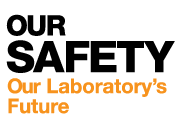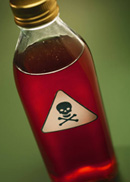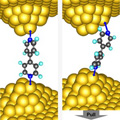



A staff research assistant who was seriously burned in a laboratory fire at UCLA died of her injuries Jan. 16. She was working with t-butyl lithium, a highly flammable compound that spontaneously burns upon exposure to air. She was extracting the compound when the syringe she was using came apart, spraying a mixture of t-butyl lithium and pentane, which caught on fire. This tragic accident is a reminder to everyone at Berkeley Lab that we often work in hazardous situations involving chemicals, radiation, machinery, and other dangerous components. The primary goal of the Lab’s safety programs is to try and prevent accidents like this. To that end, the Lab’s EH&S Division has forwarded a description of this incident to all users of pyrophoric compounds, checked the inventory of such compounds, and reviewed procedures for using them. A formal “Lessons Learned” will be generated when more information is available. More>
Go to OurSafety for more on the Lab's safety efforts.
 Research: Potential “On-Off” Switch Found for Nanoelectronic Devices
Research: Potential “On-Off” Switch Found for Nanoelectronic DevicesBerkeley Lab researchers at The Molecular Foundry, led by Jeffrey Neaton, who heads the Theory of Nanostructured Materials facility, have shown that electrical resistance through a molecular junction—a nanometer scale circuit element that contacts gold atoms with a single molecule—can be turned ‘on’ and ‘off’ simply by pushing and pulling the junction. This feature has potential for being used as a switch in future nanoscale electronic devices. More>
 Because Phase 1 construction of the User Support Building is complete, and the next phase is awaiting receipt of capital funding, some parking spaces in the area will be temporarily open for staff. About 18 regular parking spaces and three government spaces in the Y Lot near Building 80, and about 14 spaces along N Road, will be available for about five weeks. Drivers are cautioned that the entrance drive to these parking areas is a narrow, single-lane space.
Because Phase 1 construction of the User Support Building is complete, and the next phase is awaiting receipt of capital funding, some parking spaces in the area will be temporarily open for staff. About 18 regular parking spaces and three government spaces in the Y Lot near Building 80, and about 14 spaces along N Road, will be available for about five weeks. Drivers are cautioned that the entrance drive to these parking areas is a narrow, single-lane space.
 People: CRD Researchers Contribute to SIAM CSE09 Conference
People: CRD Researchers Contribute to SIAM CSE09 ConferenceSeveral Computational Research Division researchers are contributing to the SIAM Conference on Computational Science and Engineering being held this week in Miami, Florida. Juan Meza (right) is on the program committee, and David Bailey (left) is giving an invited talk on “Experimental Mathematics, Multicore Processors and Highly Parallel Computing.” Tony Drummond (center) will be one of the busiest people at CSE09, co-organizing two mini-symposiums and giving three talks. Many other Lab researchers are organizing, presenting or coauthoring at the conference as well. More>
 Campus Update: New CITRIS Headquarters, Sutardja Dai Hall, Dedicated
Campus Update: New CITRIS Headquarters, Sutardja Dai Hall, DedicatedAt a ceremony last Friday, the newly built Sutardja Dai Hall was officially dedicated as the new home of the Center for Information Technology Research in the Interest of Society (CITRIS). CITRIS is a multi-disciplinary program that brings together more than 300 faculty researchers and thousands of students from four UC campuses with industrial partners from more than 60 corporations. Among CITRIS’s current projects is the CellScope, which turns a conventional cell phone into a compact, high-resolution, handheld microscope with the capability to capture, organize and wirelessly transmit images for analysis. The CellScope was developed by Berkeley Lab physical bioscientist Daniel Fletcher. More>
 [Mercury News] Deep in the $787 billion stimulus bill that recently became law is $400 million to launch ARPA-E, the Advanced Research Projects Authority for Energy. It's modeled after the Pentagon's DARPA, the Defense Advanced Research Projects Agency. The goal is to pump money into high-risk, high-reward research to pursue breakthroughs in areas such as batteries for hybrid vehicles, advanced biofuels and cheaper, more powerful solar panels. The approach is to rely on Silicon Valley-style innovation and collaboration between government, academia and the private sector, and work outside normal bureaucratic structures. More>
[Mercury News] Deep in the $787 billion stimulus bill that recently became law is $400 million to launch ARPA-E, the Advanced Research Projects Authority for Energy. It's modeled after the Pentagon's DARPA, the Defense Advanced Research Projects Agency. The goal is to pump money into high-risk, high-reward research to pursue breakthroughs in areas such as batteries for hybrid vehicles, advanced biofuels and cheaper, more powerful solar panels. The approach is to rely on Silicon Valley-style innovation and collaboration between government, academia and the private sector, and work outside normal bureaucratic structures. More>
Today at Berkeley Lab is produced by Public Affair's Communications Department